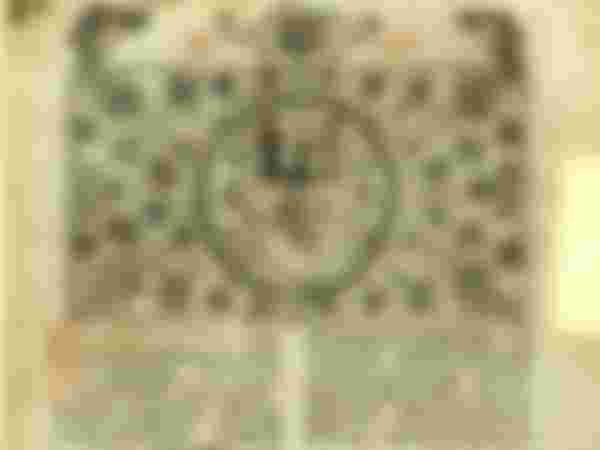The photo shows a detail of the famous Cetinje Octoichus, the oldest incunabula in the Serbo-Slavic language, which can also be viewed in the Digital National Library of Serbia. This famous book was written in Cetinje in 1494, a few decades after Gutenberg invented the printing press and only a few years before the Turks conquered the last free territory in the Balkans, and with it the first printing house here.

Incunabula, namely, are not manuscripts, but printed books. They were printed on the finest parchment, processed animal skin, and then beautifully illuminated, painted like medieval manuscripts, and therefore largely resemble manuscripts. However, the name incunabula means an early printed book that was made until the beginning of the 16th century.
The term originated from the Latin phrase ab incunabulis, from the collection, since it means books from the initial phase of the history of the press. Since Johann Gutenberg printed the first 180 copies of his Bible in 42 lines in Mainz in 1455, the press - unlike other inventions in the late Middle Ages - has spread extremely fast in Europe. It is believed that during this period, tens of thousands of specimens of various incunabula were created, which are of great value today.
Incunabula are a testimony to a change in the technological paradigm, a seal in a series of hints of a new age. Namely, manuscripts are no longer a rarity in this age of human history. Manuscripts have been made, painted and bound in codices in various places for centuries, starting with the famous transcription workshop in Vivarium in Italy, the entire manuscript industry in Byzantine Constantinople, Benedictine monastery scriptoriums in northern Europe, and then the cities where the first universities sprang up.
But a printed book is literally changing the world - it is produced faster, more reliably and cheaper. And in less than half a century, it has completely suppressed manuscripts.
Since it takes several months and years to make a transcript of only one Four Gospels, despite so many workshops, one manuscript book cost a fortune at the dawn of the press - about 10 ducats, which is astonishingly large money and corresponds to the value of a small herd of ten cows. The printed book had a significantly lower price (although it was far from cheap) - it was noted that Serbian printers in Venice, Božidar and later Vicenzo Vuković, asked for three for the Gospel, and sold the Psalter for one ducat. Gutenberg's famous Bible was worth 30 florins, which is equal to the three-year salary of a court clerk.
There are two types of incunabula. The older ones were also printed, but they were created long before Gutenberg - they were made in Italian cities as early as the 14th century and were called block books. For their production, woodcut was used, ie woodcut - with the help of special knives, one printed plate was carved for each side of the wood, on which paint was applied and prints were printed. This kind of printing was of uneven quality, but it gained great popularity. In contrast, Gutenberg introduces the so-called typographic printing - where a new image from the board is not printed for each page, but movable metal letters are used, which enables higher production speed, higher number of prints and higher quality books.
The popularity of this method was so great that it is considered that by the end of the 15th century, about 1000 printing houses were opened in Europe. One of them, as the first state printing house in Europe, was founded in 1493 in Cetinje, which at that time - after the fall of the Serbian despotism under the rule of the Turks and along with their penetration into the West and North - was the last free oasis in the Balkans.
This famous printing workshop on Obod was founded by the last master of Zeta, Đurađ Crnojević, who brought the press from Venice, and in just four years of work he managed to print five editions in the Serbo-Slavic language - one Four Gospels, Psalter, Prayer Book, Oktoih petoglasnik and Oktoih prvoglasnik. which is a collection of church songs that are sung at intervals of eight days (that is why it is called octoih). Cetinje's Oktoih was completed in January 1494, in two colors, printed on 269 sheets. The circulation of the book was large, and today as many as 105 copies of this famous incunabula have been preserved.
Crnojević's printing house was run by hieromonk Makarija, who apparently was not only a newspaper but also a real initiator of the art of printing in our region. At least seven other masters worked with Makarije, and they managed to cut out Serbian Cyrillic letters for the first time and to successfully print on parchment with the help of a press brought by the Crnojevics from Venice.
Not only did he bring the printing craft from somewhere, Makarije also essentially understood the new technology, he was brave enough to use Cyrillic letters and to make real masterpieces of early printing. And that, after this endeavor, he expanded his knowledge and infected other parts with the press.
When Zeta fell under the rule of the Turks, the Crnojevics went to Venice, where the printing of Serbian books will continue in the coming decades. In the meantime, Makarije will go to Romania, where he will further expand his craft and print the first Romanian books, and later he will arrive in Hilandar, where he helped found the printing house there.
Great treasure of early Serbian write source of culture describes how is important to talents of artists and desire for protect knowledge and memory of difficult times and time generally has significant role in every history, every life and every nation.

The famous book is worth seeing live.History has a lot to offer.